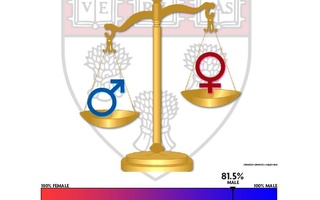Gender parity for tenure-track faculty hires was finally achieved in the Faculty of Arts and Sciences this past year, according to a draft of the Dean's Annual Report. Although the faculty, at its all-time largest size, is still heavily imbalanced, we are glad to see that new hires have demonstrated Harvard’s commitment to empowering women in academia. We hope this commitment will continue, and over time, achieve full gender-balance in the faculty. In the pursuit of this goal, we urge the university to not neglect equal opportunities for advancement within the tenure track, as well as entering it.
Historically, Harvard and other institutions of higher education have struggled to hire and retain female faculty. Across universities, women have clustered disproportionately in the non-tenure track. Because tenure is generally earned with work in the critical decade between 30 and 40, which is also the decade in which women tend to have children, women in academia are often forced to put one goal on hold for the other.
However, Harvard’s effort in recent years to emphasize the creation of a pipeline for women in academia should be praised, as well as its effort to create family-friendly programs for faculty, including millions of dollars invested in child-care centers and subsidies and grants that enable junior faculty to take children on field trips. This year’s promising gender balance will hopefully continue in future years, in the hopes of eventually reaching full gender equality.
However, the mere entrance of women into tenure-track positions is not enough: Harvard must also ensure equality in the rate of advancement. At Harvard, where tenure is only granted to full professors, which may make it especially difficult for women to ascend into senior academic positions. Tenure-track women in academia frequently face different challenges associated with maternity than even women in other professions. According to a study of married, tenure-track professors with young children, male professors are far less likely to take paternity leave, and furthermore, those who do may use the time to complete research or publish papers. This puts women at a further disadvantage.
While there is no perfect or easy solution to gender equality in Harvard faculty, it’s important to celebrate this achievement with a critical eye to the future. The faculty’s gender makeup remains disproportionately male-heavy, with 532 men and 198 women. To achieve the gender-balanced future we would like to see, we must guarantee equality throughout the tenure track—and not just at the start.
Read more in Opinion
A Walden of Your OwnRecommended Articles
-
Harvard Kennedy School Group Publicizes Gender ImbalanceThe Progressive Caucus at Harvard Kennedy School gave away home-made pastries yesterday in the John F. Kennedy Forum as a tongue-in-cheek attempt to raise awareness of the low percentage of women faculty members at the school.
-
Report Reviews Female ProfessorsThe Office of Faculty Development and Diversity included the first-ever historical overview of the role of tenured women professors across Harvard University in its 2011 Annual Report.
-
The Case for Gender DiversityThe best reason for greater gender equity may be even more fundamental—our nations need the best. We desperately need exceptional public leaders and innovative solutions to the overwhelming public problems facing the world.
-
Faculty Meeting Focuses on Online Education and Gender ImbalanceA month after administrators announced to a packed University Hall that the School of Engineering and Applied Sciences would move to Allston, Tuesday’s Faculty Meeting was comparatively uneventful, with few attendees and fewer announcements.
-
 Once Home to Kagan and Warren, HLS Faculty Still Only 20 Percent Female
Once Home to Kagan and Warren, HLS Faculty Still Only 20 Percent Female -
SEAS Adds Five Faculty MembersContinuing its growth, the School of Engineering and Applied Sciences added five new faculty members to its roster this fall, three of whom are women.













